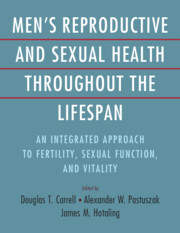 Men's Reproductive and Sexual Health Throughout the Lifespan
Men's Reproductive and Sexual Health Throughout the Lifespan Book contents
- Men’s Reproductive and Sexual Health throughout the Lifespan
- Men’s Reproductive and Sexual Health throughout the Lifespan
- Copyright page
- Contents
- Contributors
- Preface
- Section 1 An Introduction to Men’s Health Care
- Section 2 The Biology of Male Reproduction and Infertility
- Section 3 Clinical Evaluation and Treatment of Male Infertility
- Section 4 Laboratory Evaluation and Treatment of Male Infertility
- Chapter 20 The Modern Semen Analysis
- Chapter 21 The Future of Computer-Assisted Semen Analysis in the Evaluation of Male Infertility
- Chapter 22 Reactive Oxygen Species and Sperm DNA Damage
- Chapter 23 Clinical Value of Sperm DNA Fragmentation Tests
- Chapter 24 The Current Use of Sperm Function Assays
- Chapter 25 Sperm Selection in the Laboratory
- Chapter 26 Methods to Select Ejaculated, Epididymal, and Testicular Spermatozoa for Assisted Conception
- Chapter 27 Optimal Sperm Selection in the ICSI Era
- Chapter 28 Microfluidics for Sperm Sample Preparation and Sperm Identification
- Chapter 29 Practical Concerns for Patient Semen Banking
- Chapter 30 The Potential Future Applications of In Vitro Spermatogenesis in the Clinical Laboratory
- Chapter 31 Spermatogonial Stem Cell Culture and the Future of Germline Gene Editing
- Section 5 Medical and Surgical Management of Issues of Male Health
- Index
- References
Chapter 31 - Spermatogonial Stem Cell Culture and the Future of Germline Gene Editing
from Section 4 - Laboratory Evaluation and Treatment of Male Infertility
Published online by Cambridge University Press: 06 December 2023
- Men’s Reproductive and Sexual Health throughout the Lifespan
- Men’s Reproductive and Sexual Health throughout the Lifespan
- Copyright page
- Contents
- Contributors
- Preface
- Section 1 An Introduction to Men’s Health Care
- Section 2 The Biology of Male Reproduction and Infertility
- Section 3 Clinical Evaluation and Treatment of Male Infertility
- Section 4 Laboratory Evaluation and Treatment of Male Infertility
- Chapter 20 The Modern Semen Analysis
- Chapter 21 The Future of Computer-Assisted Semen Analysis in the Evaluation of Male Infertility
- Chapter 22 Reactive Oxygen Species and Sperm DNA Damage
- Chapter 23 Clinical Value of Sperm DNA Fragmentation Tests
- Chapter 24 The Current Use of Sperm Function Assays
- Chapter 25 Sperm Selection in the Laboratory
- Chapter 26 Methods to Select Ejaculated, Epididymal, and Testicular Spermatozoa for Assisted Conception
- Chapter 27 Optimal Sperm Selection in the ICSI Era
- Chapter 28 Microfluidics for Sperm Sample Preparation and Sperm Identification
- Chapter 29 Practical Concerns for Patient Semen Banking
- Chapter 30 The Potential Future Applications of In Vitro Spermatogenesis in the Clinical Laboratory
- Chapter 31 Spermatogonial Stem Cell Culture and the Future of Germline Gene Editing
- Section 5 Medical and Surgical Management of Issues of Male Health
- Index
- References
Summary
Human spermatogonial stem cells (hSSCs), the only type of germline stem cells in adult men, are responsible to ensure lifetime-long sperm production in men after sex maturation. As the starting point of spermatogenesis, this cell type delicately balances its self-renewal and differentiation, which is essential for spermatogenesis to proceed continuously. A deep and systematic understanding of hSSCs is critical for treating testis-related pathology such as male infertility and testicular germ cell tumor. In this chapter, we provide a systematic review of our previous and current understanding of hSSCs, as well as the advancement of ex vivo systems to culture human germline. Ultimately, the successful establishment of an hSSC-based human germline culture system will not only greatly benefit the study of human germ cell biology by serving as a useful platform, but also provide potential therapeutic options to treat male infertility and preserve fertility for childhood cancer patients.
- Type
- Chapter
- Information
- Men's Reproductive and Sexual Health Throughout the LifespanAn Integrated Approach to Fertility, Sexual Function, and Vitality, pp. 244 - 250Publisher: Cambridge University PressPrint publication year: 2023


